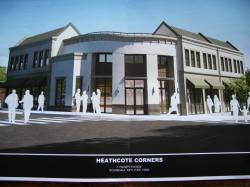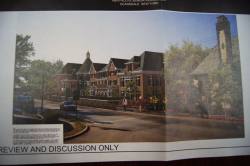Planning Board Reviews Two Projects for the Five Corners
- Category: Real Estate
- Published: Tuesday, 22 March 2011 17:08
 Developers from both sides of the Heathcote Five Corners appeared before the Scarsdale Planning Board on Wednesday March 16, at the last meeting that was lead by outgoing Board chair Beverly Sved. On the agenda was one approved project on the site of the gas station on Palmer Road, and another prospective project to be built on the parking lot of the Heathcote Tavern at 2-4 Weaver Street.
Developers from both sides of the Heathcote Five Corners appeared before the Scarsdale Planning Board on Wednesday March 16, at the last meeting that was lead by outgoing Board chair Beverly Sved. On the agenda was one approved project on the site of the gas station on Palmer Road, and another prospective project to be built on the parking lot of the Heathcote Tavern at 2-4 Weaver Street.
First up were Doug Brout and Brad Perkins requesting clarification on who was responsible for building a cul-de-sac and improvements to Secor Road that were shown on an approved site plan for the project at 1 Palmer Avenue. Brout and Perkins already have approval to build an 11,000 square foot retail building on the site of the gas station at Palmer and Weaver Streets. However, in order to ease traffic in the area, the Village asked them to design the parking lot so that cars enter and exit via the Balducci’s lot on Secor Road. This would require reconfiguration of curbing and landscaping of Secor Road. In addition, a cul-de-sac is to be constructed next to Balducci’s to block cars from entering the lot from the adjacent residential neighborhood and to serve as a pass through for pedestrians and cyclists.
When the Planning Board approved the site plan, it was their understanding that the developers would pay for this work which is estimated at $100,000-$180,000. However Brout and Perkins came before the Board on 3/16 to say that it was unclear that these renovations were their responsibility and that they wanted to share the cost for improvements with the Village. In their eyes, these are enhancements to Village property over 200 feet away from their new retail building.
Sved contended that when the Board gave approval for the site plan it was conditional on the construction of the cul-de-sac, but Perkins argued that, “we agreed to it but did not agree we would pay for it. It has nothing to do with our project.”
Village Planner Liz Marrinan explained the history of the project, saying, “the project had a long and tortuous history. It was originally introduced in 2008. And it was originally just the 1 Palmer Avenue plan. In 2009 the Village approached the developers about a combined site plan to include Balducci’s. There was no discussion of using Village dollars. The applicant amended the plan to include the cul-de -sac. Typically the site plan that is submitted is the one that the applicant intends to build. After the environmental evaluation the applicant came back with the single plan in March 2010 and it was approved. But they agreed to work with Balducci’s on the combined project. In May 2010 they received final approval on the whole kit and kaboodle."
Brout and Perkins then asked for a business meeting with the Village Manager and Board of Trustees to seek financing for the improvements. However, the Planning Board, Village Planner and the Village Attorney all agreed that since the approved site plan indicated that the cul-de-sac was the developers responsibility, they could not proceed. If the developers wanted to go ahead with the retail building without the cul-de-sac and improvements to Secor Road, they would need to file an amended site plan for review by the Planning Board.
At the end of the meeting, Sved said the Board would discuss the issue and make a ruling. Following the meeting, the Planning Board denied Brout and Perkins’ request for an amended site plan to exclude the cul-de-sac and improvements to Secor Road.
Also before the Board on March 16 were developer Steven Oder and architect Richard Behr to discuss a 30,000 square foot, four-story  residential building with 10 apartments to be built on the parking lot at 2-4 Weaver Street. They came before the Board to review the project and get an initial reaction. Oder and Frederick Fish had originally sought to purchase the strip of Village owned land that serves as the driveway to the Tavern parking lot to expand the scope of the project. However since the Village turned them down, they are now proposing a smaller project that could be built on the land they own. Had they been allowed to purchase the driveway they would have built 14 units, but now the project has been scaled back to 10 units.
residential building with 10 apartments to be built on the parking lot at 2-4 Weaver Street. They came before the Board to review the project and get an initial reaction. Oder and Frederick Fish had originally sought to purchase the strip of Village owned land that serves as the driveway to the Tavern parking lot to expand the scope of the project. However since the Village turned them down, they are now proposing a smaller project that could be built on the land they own. Had they been allowed to purchase the driveway they would have built 14 units, but now the project has been scaled back to 10 units.
In order to build the project they would need variances for side yard and rear setbacks, however they argued that since neither the side nor the back abuts residential property these variances should not be an issue. They also claimed that if the Village could not grant the variances they could “shoehorn” the building onto the smaller plot.
The project would include 20 parking spaces for the 10 residential units, to be built one level up from the restaurant parking lot. Current Village code calls for one parking space for every 750 square feet of leasable space so technically they would be required to build 40 spaces and would require a variance for the smaller number of spaces.
The developer did not provide an updated rendering of the design of the building and used drawings from the prior proposal so that the Board could not get a fix on the appearance or bulk of the proposed new building. One Board member noted the 11-foot ceilings and questioned why the building was so tall.
Oder explained that luxury housing required high ceilings. They also answered that if the Village had sold them the driveway they could have spread out the building and made it lower. But without the extra land they needed to build up.
Sved suggested that a new Board of Trustees and Planning Board would be in place soon and suggested that Fish and Oder reapply to purchase the Village driveway. To that Oder replied, “we need to find a way to get this accomplished. If it is simple, okay. If not, no. We already use the land (the driveway). It would be a better piece of architecture with the Village driveway. It has been a long journey.”
Board member Jane Veron reminded Oder that the project had originally included senior housing and asked Oder what he thought about that now. Oder replied, “it is now a financing problem. Banks are not approving loans for restricted housing.” And about affordable housing, they said, “these are big units and we cannot afford to do affordable.” However the Village is now considering a change in code to require any developer constructing a residential building in any area of the village zoned for multifamily housing to make 10% of the units ‘affordable’, so Fish and Oder may have no choice.
As this was simply a pre-application conference, no decisions needed to be made by the Board at this time. It will be interesting to watch the evolution of this new proposal as it makes its way through the newly appointed Planning Board and Board of Architectural Review.









